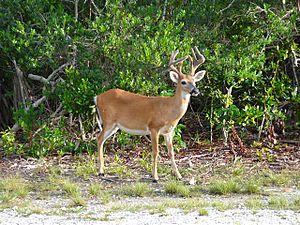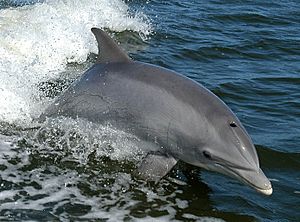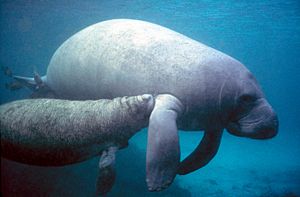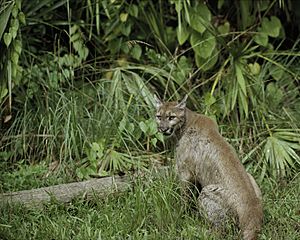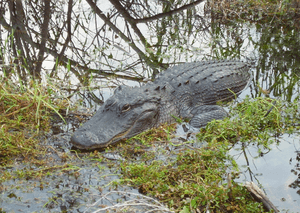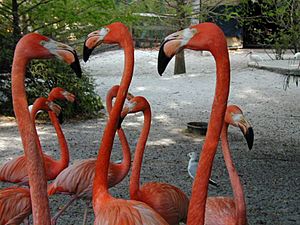Fauna of Florida facts for kids
Florida is a sunny state in the southeastern United States that's famous for its amazing wildlife! It's home to many different kinds of animals, from tiny insects to huge marine mammals. Let's explore some of the cool creatures you can find here.
Contents
Florida's Amazing Animals
Mammals You Might See
Florida has many fascinating mammals, both on land and in the water.
Marine Mammals
In the waters around Florida, you can spot incredible marine mammals. The bottlenose dolphin is a common sight, often seen playing near boats. Gentle giants like the West Indian manatee swim slowly in Florida's rivers and coastal areas, munching on plants. The North Atlantic right whale is a very rare whale that comes to the coasts of Florida and Georgia to have its babies.
Land Mammals
On land, Florida is home to the rare Florida panther, a type of big cat. These beautiful animals are mostly found in South Florida. Their numbers have grown from only about 300 in the 1970s to around 3,000 today! You might also see white-tailed deer and the smaller Key deer, which live only in the Florida Keys. Other common mammals include raccoons, squirrels, and Florida black bears.
Reptiles and Amphibians
Florida's warm climate is perfect for many reptiles and amphibians.
Alligators and Crocodiles
Florida is one of the few places where you can find both American alligators and American crocodiles. Alligators are very common, with about a million of them in the state. Crocodiles are much rarer, with only about 1,500. They usually live in saltwater areas in South Florida.
Snakes and Turtles
You can find many types of snakes, including the eastern diamondback rattlesnake and the eastern indigo snake. Florida is also home to the gopher tortoise, a land turtle that digs deep burrows. Sea turtles, like the green and leatherback sea turtles, lay their eggs on Florida's beaches.
Birds in the Sunshine State
Florida is a paradise for birds, especially during winter when many species fly south to escape the cold.
Famous Florida Birds
One of the most famous birds is the American flamingo, known for its bright pink feathers. These flamingos are making a comeback in South Florida. You might also see majestic birds like the bald eagle and the osprey soaring overhead. Large wading birds like the white and brown pelicans, roseate spoonbills, and whooping and sandhill cranes are common near water. The Florida scrub jay is special because it lives only in Florida.
Wild Turkeys
A unique type of wild turkey, called the osceola subspecies, is found only in Florida.
Insects and Other Small Creatures
Even the smallest creatures play a big role in Florida's ecosystem.
Native Insects
Florida has many native insects, including Miami blue butterflies and different kinds of bees. There are 29 types of bees that live only in Florida and nowhere else in the world! Many of these bees are important pollinators, helping plants grow.
Animals from Other Places (Invasive Species)
Florida has more than 500 types of animals and 1,000 types of insects that are not native to the state. These are called nonnative or exotic species. Some of them, like the Burmese python and green iguana, can cause problems for Florida's native animals by competing for food or eating them.
Invasive Reptiles
The Burmese python is a large snake that has become a big problem in the Everglades. They eat many native animals, like birds and mammals. The green iguana has also become very common in South Florida. To help control these populations, the state sometimes allows special hunting seasons for these nonnative reptiles.
Other Invasive Animals
Other nonnative animals include the lionfish in the ocean, peacock bass in freshwater, and even some monkeys like the rhesus macaque. There are also many feral pigs in Florida, which can damage the environment.
Restoring Florida's Wildlife
People in Florida work hard to protect and restore native animal populations.
Bison in Paynes Prairie
At Paynes Prairie Preserve State Park, plains bison were brought back in 1975. These large animals used to roam Florida hundreds of years ago. The park manages the herd to keep it healthy and help restore the natural environment.
Lists
There are a number of invasive species in the state:
- Invasive species
- in the Everglades
- Fish


